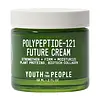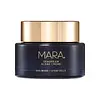What's inside
What's inside
 Key Ingredients
Key Ingredients

 Benefits
Benefits

 Concerns
Concerns

 Ingredients Side-by-side
Ingredients Side-by-side

Water
Skin ConditioningDicaprylyl Carbonate
EmollientHydrolyzed Hyaluronic Acid
HumectantTrimethylolpropane Tricaprylate/Tricaprate
EmollientTridecyl Trimellitate
EmollientPropanediol
SolventSh-Polypeptide-121
Skin ConditioningPolyglyceryl-3 Methylglucose Distearate
EmulsifyingPanthenol
Skin ConditioningNiacinamide
SmoothingProline
Skin ConditioningTocopheryl Acetate
AntioxidantAloe Barbadensis Leaf Juice
Skin ConditioningHydrolyzed Cannabis Sativa Seed Extract
Skin ConditioningHydrolyzed Rice Protein
Skin ConditioningHydrolyzed Pea Protein
EmollientSalvia Hispanica Seed Extract
EmollientAcetyl Tetrapeptide-11
Skin ConditioningAcetyl Tetrapeptide-9
Skin ConditioningAcetyl Tetrapeptide-2
Skin ConditioningHibiscus Esculentus Fruit Extract
Skin ConditioningAmmonium Acryloyldimethyltaurate/Beheneth-25 Methacrylate Crosspolymer
Emulsion StabilisingHydrolyzed Linseed Seed
HumectantCastor Oil/Ipdi Copolymer
Ceramide AP
Skin ConditioningCeramide NP
Skin ConditioningCetearyl Alcohol
EmollientCetearyl Glucoside
EmulsifyingGlycerin
HumectantHydrolyzed Sodium Hyaluronate
Skin ConditioningCoco-Caprylate/Caprate
EmollientDilinoleic Acid
EmollientBenzyl Alcohol
PerfumingZingiber Officinale Root Extract
MaskingBisabolol
MaskingCaprylyl Glycol
EmollientCarbomer
Emulsion StabilisingDimethyl Isosorbide
SolventDipropylene Glycol
HumectantErythritol
HumectantEthylhexylglycerin
Skin ConditioningGlucose
Humectant1,2-Hexanediol
Skin ConditioningTrisodium Ethylenediamine Disuccinate
Glyceryl Stearate
EmollientPhytosphingosine
Skin ConditioningPolyacrylate Crosspolymer-6
Emulsion StabilisingPolysorbate 20
EmulsifyingCaprylhydroxamic Acid
Potassium Sorbate
PreservativeGlycine
BufferingHydroxyacetophenone
AntioxidantSodium Benzoate
MaskingT-Butyl Alcohol
PerfumingCitric Acid
BufferingSodium Citrate
BufferingSodium Lactate
BufferingTriheptanoin
Skin ConditioningXanthan Gum
EmulsifyingWater, Dicaprylyl Carbonate, Hydrolyzed Hyaluronic Acid, Trimethylolpropane Tricaprylate/Tricaprate, Tridecyl Trimellitate, Propanediol, Sh-Polypeptide-121, Polyglyceryl-3 Methylglucose Distearate, Panthenol, Niacinamide, Proline, Tocopheryl Acetate, Aloe Barbadensis Leaf Juice, Hydrolyzed Cannabis Sativa Seed Extract, Hydrolyzed Rice Protein, Hydrolyzed Pea Protein, Salvia Hispanica Seed Extract, Acetyl Tetrapeptide-11, Acetyl Tetrapeptide-9, Acetyl Tetrapeptide-2, Hibiscus Esculentus Fruit Extract, Ammonium Acryloyldimethyltaurate/Beheneth-25 Methacrylate Crosspolymer, Hydrolyzed Linseed Seed, Castor Oil/Ipdi Copolymer, Ceramide AP, Ceramide NP, Cetearyl Alcohol, Cetearyl Glucoside, Glycerin, Hydrolyzed Sodium Hyaluronate, Coco-Caprylate/Caprate, Dilinoleic Acid, Benzyl Alcohol, Zingiber Officinale Root Extract, Bisabolol, Caprylyl Glycol, Carbomer, Dimethyl Isosorbide, Dipropylene Glycol, Erythritol, Ethylhexylglycerin, Glucose, 1,2-Hexanediol, Trisodium Ethylenediamine Disuccinate, Glyceryl Stearate, Phytosphingosine, Polyacrylate Crosspolymer-6, Polysorbate 20, Caprylhydroxamic Acid, Potassium Sorbate, Glycine, Hydroxyacetophenone, Sodium Benzoate, T-Butyl Alcohol, Citric Acid, Sodium Citrate, Sodium Lactate, Triheptanoin, Xanthan Gum
Palmaria Palmata Extract
Skin ProtectingWater
Skin ConditioningRicinus Communis Seed Oil
MaskingTheobroma Grandiflorum Seed Butter
Skin ConditioningPentylene Glycol
Skin ConditioningCetearyl Alcohol
EmollientGlycerin
HumectantGlyceryl Stearate
EmollientCetearyl Olivate
Citrullus Lanatus Seed Oil
EmollientMoringa Oleifera Seed Oil
EmollientGlyceryl Caprylate
EmollientSorbitan Olivate
EmulsifyingSqualane
EmollientSodium Gluconate
Skin ConditioningSodium Lactate
BufferingCetyl Hydroxyethylcellulose
Emulsion StabilisingMaris Aqua
HumectantSodium Stearoyl Glutamate
CleansingKappaphycus Alvarezii Extract
Skin ConditioningCaprylic/Capric Triglyceride
MaskingCaprylhydroxamic Acid
Eclipta Prostrata Extract
Skin ConditioningLimnanthes Alba Seed Oil
Skin ConditioningVaccinium Myrtillus Seed Oil
Skin ConditioningOenothera Biennis Oil
EmollientCrambe Abyssinica Seed Oil
Skin ConditioningAdansonia Digitata Seed Oil
EmollientMalus Domestica Fruit Cell Culture Extract
Skin ConditioningVitis Vinifera Seed Oil
EmollientSodium Phytate
Sodium PCA
HumectantLecithin
EmollientBenzoic Acid
MaskingHydrolyzed Pinus Sibirica Seedcake Extract
Skin ConditioningGigartina Stellata Extract
Skin ProtectingChondrus Crispus Extract
Skin ConditioningSodium Nitrate
SoothingXanthan Gum
EmulsifyingCystoseira Tamariscifolia Extract
Skin ConditioningHydrated Silica
AbrasiveAlaria Esculenta Extract
Skin ProtectingSodium Benzoate
MaskingAcanthopanax Senticosus Root Extract
Skin ConditioningDisodium Phosphate
BufferingTocopherol
AntioxidantSilica Dimethyl Silylate
EmollientSodium Phosphate
BufferingPotassium Sorbate
PreservativeSodium Hydroxide
BufferingPalmaria Palmata Extract, Water, Ricinus Communis Seed Oil, Theobroma Grandiflorum Seed Butter, Pentylene Glycol, Cetearyl Alcohol, Glycerin, Glyceryl Stearate, Cetearyl Olivate, Citrullus Lanatus Seed Oil, Moringa Oleifera Seed Oil, Glyceryl Caprylate, Sorbitan Olivate, Squalane, Sodium Gluconate, Sodium Lactate, Cetyl Hydroxyethylcellulose, Maris Aqua, Sodium Stearoyl Glutamate, Kappaphycus Alvarezii Extract, Caprylic/Capric Triglyceride, Caprylhydroxamic Acid, Eclipta Prostrata Extract, Limnanthes Alba Seed Oil, Vaccinium Myrtillus Seed Oil, Oenothera Biennis Oil, Crambe Abyssinica Seed Oil, Adansonia Digitata Seed Oil, Malus Domestica Fruit Cell Culture Extract, Vitis Vinifera Seed Oil, Sodium Phytate, Sodium PCA, Lecithin, Benzoic Acid, Hydrolyzed Pinus Sibirica Seedcake Extract, Gigartina Stellata Extract, Chondrus Crispus Extract, Sodium Nitrate, Xanthan Gum, Cystoseira Tamariscifolia Extract, Hydrated Silica, Alaria Esculenta Extract, Sodium Benzoate, Acanthopanax Senticosus Root Extract, Disodium Phosphate, Tocopherol, Silica Dimethyl Silylate, Sodium Phosphate, Potassium Sorbate, Sodium Hydroxide
 Reviews
Reviews

Ingredients Explained
These ingredients are found in both products.
Ingredients higher up in an ingredient list are typically present in a larger amount.
Caprylhydroxamic Acid is a chelating agent.
Chelating agents help prevent metal ions from binding to other ingredients. This helps prevent unwanted reactions and effects from using the product.
Caprylhydroxamic Acid is often used with natural antimicrobial products as an alternative to preservatives.
Learn more about Caprylhydroxamic AcidCetearyl alcohol is a mixture of two fatty alcohols: cetyl alcohol and stearyl alcohol. It is mainly used as an emulsifier. Emulsifiers help prevent the separation of oils and products. Due to its composition, it can also be used to thicken a product or help create foam.
Cetearyl alcohol is an emollient. Emollients help soothe and hydrate the skin by trapping moisture.
Studies show Cetearyl alcohol is non-toxic and non-irritating. The FDA allows products labeled "alcohol-free" to have fatty alcohols.
This ingredient is usually derived from plant oils such as palm, vegetable, or coconut oils. There is debate on whether this ingredient will cause acne.
Due to the fatty acid base, this ingredient may not be Malassezia folliculitis safe.
Learn more about Cetearyl AlcoholGlycerin is already naturally found in your skin. It helps moisturize and protect your skin.
A study from 2016 found glycerin to be more effective as a humectant than AHAs and hyaluronic acid.
As a humectant, it helps the skin stay hydrated by pulling moisture to your skin. The low molecular weight of glycerin allows it to pull moisture into the deeper layers of your skin.
Hydrated skin improves your skin barrier; Your skin barrier helps protect against irritants and bacteria.
Glycerin has also been found to have antimicrobial and antiviral properties. Due to these properties, glycerin is often used in wound and burn treatments.
In cosmetics, glycerin is usually derived from plants such as soybean or palm. However, it can also be sourced from animals, such as tallow or animal fat.
This ingredient is organic, colorless, odorless, and non-toxic.
Glycerin is the name for this ingredient in American English. British English uses Glycerol/Glycerine.
Learn more about GlycerinGlyceryl Stearate is a mix of glycerin and stearic acid.
It is used to stabilize the mixing of water and oil ingredients. By preventing these ingredients from separating, it can help elongate shelf life. It can also help thicken the product's texture.
As an emollient, it helps soften skin and supports barrier-replenishing ingredients.
In cosmetics, Glyceryl Stearate is often made from vegetable oils or synthetically produced.
This ingredient may not be fungal-acne safe
Fun fact: The human body also creates Glyceryl Stearate naturally.
Learn more about Glyceryl StearatePotassium Sorbate is a preservative used to prevent yeast and mold in products. It is commonly found in both cosmetic and food products.
This ingredient comes from potassium salt derived from sorbic acid. Sorbic acid is a natural antibiotic and effective against fungus.
Both potassium sorbate and sorbic acid can be found in baked goods, cheeses, dried meats, dried fruit, ice cream, pickles, wine, yogurt, and more.
You'll often find this ingredient used with other preservatives.
Learn more about Potassium SorbateSodium Benzoate is a preservative. It's used in both cosmetic and food products to inhibit the growth of mold and bacteria. It is typically produced synthetically.
Both the US FDA and EU Health Committee have approved the use of sodium benzoate. In the US, levels of 0.1% (of the total product) are allowed.
Sodium benzoate works as a preservative by inhibiting the growth of bacteria inside of cells. It prevents the cell from fermenting a type of sugar using an enzyme called phosphofructokinase.
It is the salt of benzoic acid. Foods containing sodium benzoate include soda, salad dressings, condiments, fruit juices, wines, and snack foods.
Studies for using ascorbic acid and sodium benzoate in cosmetics are lacking, especially in skincare routines with multiple steps.
We always recommend speaking with a professional, such as a dermatologist, if you have any concerns.
Learn more about Sodium BenzoateSodium Lactate is the sodium salt of lactic acid, an AHA. It is a humectant and sometimes used to adjust the pH of a product.
This ingredient is part of our skin's NMF, or natural moisturizing factor. Our NMF is essential for the hydration of our top skin layers and plasticity of skin. NMF also influences our skin's natural acid mantle and pH, which protects our skin from harmful bacteria.
High percentages of Sodium Lactate can have an exfoliating effect.
Fun fact: Sodium Lactate is produced from fermented sugar.
Learn more about Sodium LactateWater. It's the most common cosmetic ingredient of all. You'll usually see it at the top of ingredient lists, meaning that it makes up the largest part of the product.
So why is it so popular? Water most often acts as a solvent - this means that it helps dissolve other ingredients into the formulation.
You'll also recognize water as that liquid we all need to stay alive. If you see this, drink a glass of water. Stay hydrated!
Learn more about WaterXanthan gum is used as a stabilizer and thickener within cosmetic products. It helps give products a sticky, thick feeling - preventing them from being too runny.
On the technical side of things, xanthan gum is a polysaccharide - a combination consisting of multiple sugar molecules bonded together.
Xanthan gum is a pretty common and great ingredient. It is a natural, non-toxic, non-irritating ingredient that is also commonly used in food products.
Learn more about Xanthan Gum